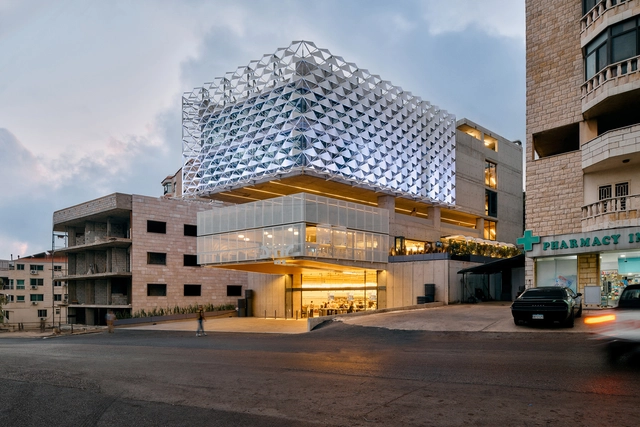
-
Architects: nunc Architecture and Design
- Area: 4000 m²
- Year: 2024




.jpg?1625498401&format=webp&width=640&height=580)
Herzog & de Meuron's rehabilitation of Porta Volta took up themes of Milanese urbanism and architecture, which has defined the city's urban fabric throughout the years. The project's design was developed after an intensive historical analysis of the site - a site which dates back to the 16th century and holds remains of when the Romans defined the city's boundaries. Architectural photographer Bahaa Ghoussainy captured Herzog & de Meuron's Lombardian-inspired structure, highlighting its modernized nod to historic architecture.

The Golden Lion for Lifetime Achievement of the 17th International Architecture Exhibition of La Biennale di Venezia was awarded to Spanish architect, educator, critic, and theoretician Rafael Moneo. Selected by the Board of Directors of La Biennale di Venezia, upon recommendation of the Curator of the Biennale Architettura 2021, Hashim Sarkis, the acknowledgment will be awarded to the architect on Saturday, May 22nd, 2021 together with the Special Golden Lion for Lifetime Achievement in memoriam to Lina Bo Bardi.

In response to the housing crisis in Europe after World War II, Le Corbusier began designing large-scale residential structures for the victims of the war. One of his most notable communal housing projects was the Berlin Unite d’ Habitation, also known as the Corbusierhaus. Completed in 1959, the project was designed to give Germany a more modern appeal, as it was trying to redefine itself after both the Second World War and Cold War.
To highlight the building’s particular exterior composition, architectural photographer Bahaa Ghoussainy explored Le Corbusier’s housing unit, putting its characteristics on full display.

.jpg?1575455535&format=webp&width=640&height=580)
For the 1957 International Builders Fair, Oscar Niemeyer developed the Interbau Apartment House, a modernist eight-storey building that sits on V-shaped pillars in the city of Berlin. While the building's facade consists of uniform windows and loggias clad with primary-colored mosaics, it is interrupted by enclosed pathways that connect the structure to the external elevator.
Architectural photographer Bahaa Ghoussainy explored the building and highlighted the complementary relationship between its uniform modernity and dynamic suspensions.

The Berlin Philharmonic by Hans Scharoun is one of the most prominent mid-20th century structures in the German city. The expressionist-style building with its bright-colored facade is the first of its kind by the German architect, as well as his most famous project to date. Scharoun’s design interprets rhythm and music as architecture, both conceptually and physically.
Architectural photographer Bahaa Ghoussainy unfolds Scharoun’s unique architecture by highlighting the concert hall’s dramatic angular geometry, vibrant yellow-hued facade, and play of lines and forms.
.jpg?1548941027&format=webp&width=640&height=580)
In the heart of Berlin resides an architectural metaphor of invisibility, emptiness, and anarchy forged by the Second World War upon the Jewish citizens. The expansion of the original Jewish museum, which was first organized as an anonymous competition by the Berlin government, was proposed as a means of bringing back Jewish presence, retracing their culture and religion into the German city. Renowned architect Daniel Libeskind, who was chosen to develop the project, used architecture as a form of expression, and created a museum that narrates the Jewish civilization before, during, and after the Holocaust.

.jpg?1527226454&format=webp&width=640&height=580)
In the town of Moukhtara, Mount Lebanon, L.E.FT Architects have transformed a 100-square-meter structure into a symbolic, picturesque mosque. The Amir Shakib Arslan mosque is a rendition of old versus new with a white steel structure overlaid onto an existing building of cross-vaulted masonry. The angular geometry of the steel plates is a result of the structure’s alignment in relation to Mecca.
Lebanese architectural photographer Bahaa Ghoussainy has released a new series of images which accentuate the contrast that lies between the architectural design of the mosque and the traditional representation of Islamic mosques and prayers. The juxtaposition of an Islamic holy place built in a non-Islamic town is translated into the architecture’s design, merging two dissonant styles into one complementary structure.
.jpg?1526579450)
With its monumental form, swept diagonal lines and elevated concrete walkways, the Issam Fares Institute building at the American University of Beirut by Zaha Hadid Architects emphasizes movement, evoking the speed of contemporary life as it presides over a connecting system of pedestrian walkways. Begun in 2006 and completed in 2014, Hadid’s award-winning concrete and glass building makes a bold statement with its prominent 21-meter, two-story-tall cantilever, which creates a covered courtyard and reduces the footprint of the building to avoid blocking circulation routes. The elevated walkways carry pedestrians through the branches of huge Cypress and Ficus trees, many of which significantly predate the building at 120 to 180 years old.
.jpg?1525882270&format=webp&width=640&height=580)
When Spanish architect Rafael Moneo won the Pritzker Prize in 1996, the jury identified his ability to see buildings as lasting built entities—their lives extending beyond architectural drawings—as integral to his success. The South Souks, Moneo’s 2009 project in Beirut, Lebanon, indeed responds to a long history and anticipates a lasting future. After the city’s historic souq (outdoor marketplace) was destroyed during the Lebanese Civil War, developer Solidere began rebuilding the commercial area in 1991. As part of the project, Moneo designed an arcaded shopping district that follows the ancient Hellenistic grid and retains original street names.
.jpg?1515170830)
In the rapidly burgeoning city of Beirut, the post-war building boom is far from over. Much like its middle-eastern neighbors, it boasts of a plump share of designer architecture—as critic Oliver Wainwright refers to it, “a diverse shopping list”. It is here that the Beirut Terraces, a residential complex designed by Herzog & De Meuron, rises up to 119 meters, occupying a prominent place in the city’s skyline. In this collection of photographs by Bahaa Ghoussainy, one sees the Beirut Terraces from within, getting a glimpse of both the interior, as well as the multiple, unique views offered from inside the building.